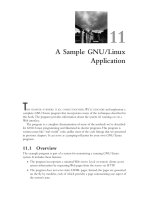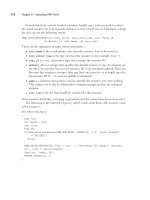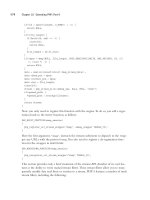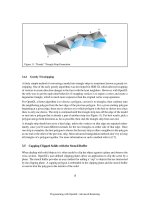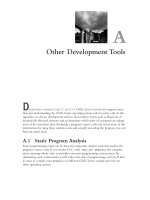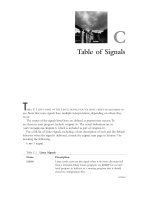Advanced python programming
Bạn đang xem bản rút gọn của tài liệu. Xem và tải ngay bản đầy đủ của tài liệu tại đây (194.31 KB, 126 trang )
Advanced Python Programming
David M. Beazley
Department of Computer Science
University of Chicago
O’Reilly Open Source Conference
July 17, 2000
O’Reilly OSCON 2000, Advanced Python Programming, Slide 1
July 17, 2000,
Overview
Advanced Programming Topics in Python
A brief introduction to Python
Working with the filesystem.
Operating system interfaces
Programming with Threads
Network programming
Database interfaces
Restricted execution
Extensions in C.
This is primarily a tour of the Python library
Everything covered is part of the standard Python distribution.
Goal is to highlight many of Python’s capabilities.
O’Reilly OSCON 2000, Advanced Python Programming, Slide 2
July 17, 2000,
Preliminaries
Audience
Experienced programmers who are familiar with advanced programming topics in other languages.
Python programmers who want to know more.
Programmers who aren’t afraid of gory details.
Disclaimer
This tutorial is aimed at an advanced audience
I assume prior knowledge of topics in Operating Systems and Networks.
Prior experience with Python won’t hurt as well.
My Background
I was drawn to Python as a C programmer.
Primary interest is using Python as an interpreted interface to C programs.
Wrote the "Python Essential Reference" in 1999 (New Riders Publishing).
All of the material presented here can be found in that source.
O’Reilly OSCON 2000, Advanced Python Programming, Slide 3
July 17, 2000,
A Very Brief Tour of Python
O’Reilly OSCON 2000, Advanced Python Programming, Slide 4
July 17, 2000,
Starting and Stopping Python
Unix
unix % python
Python 1.5.2 (#1, Sep 19 1999, 16:29:25) [GCC 2.7.2.3] on linux2
Copyright 1991-1995 Stichting Mathematisch Centrum, Amsterdam
>>>
On Windows and Macintosh
Python is launched as an application.
An interpreter window will appear and you will see the prompt.
Program Termination
Programs run until EOF is reached.
Type Control-D or Control-Z at the interactive prompt.
Or type
raise SystemExit
O’Reilly OSCON 2000, Advanced Python Programming, Slide 5
July 17, 2000,
Your First Program
Hello World
>>> print "Hello World"
Hello World
>>>
Putting it in a file
# hello.py
print "Hello World"
Running a file
unix % python hello.py
Or you can use the familiar #! trick
#!/usr/local/bin/python
print "Hello World"
O’Reilly OSCON 2000, Advanced Python Programming, Slide 6
July 17, 2000,
Variables and Expressions
Expressions
Standard mathematical operators work like other languages:
3 + 5
3 + (5*4)
3 ** 2
’Hello’ + ’World’
Variable assignment
a
b
c
a
=
=
=
=
4 << 3
a * 4.5
(a+b)/2.5
"Hello World"
Variables are dynamically typed (No explicit typing, types may change during execution).
Variables are just names for an object. Not tied to a memory location like in C.
O’Reilly OSCON 2000, Advanced Python Programming, Slide 7
July 17, 2000,
Conditionals
if-else
# Compute maximum (z) of a and b
if a < b:
z = b
else:
z = a
The pass statement
if a < b:
pass
else:
z = a
# Do nothing
Notes:
Indentation used to denote bodies.
pass used to denote an empty body.
There is no ’?:’ operator.
O’Reilly OSCON 2000, Advanced Python Programming, Slide 8
July 17, 2000,
Conditionals
elif statement
if a == ’+’:
op = PLUS
elif a == ’-’:
op = MINUS
elif a == ’*’:
op = MULTIPLY
else:
op = UNKNOWN
Note: There is no switch statement.
Boolean expressions: and, or, not
if b >= a
if not (b
and b <= c:
"b is between a and c"
< a or b > c):
"b is still between a and c"
O’Reilly OSCON 2000, Advanced Python Programming, Slide 9
July 17, 2000,
Basic Types (Numbers and Strings)
Numbers
a
b
c
d
=
=
=
=
3
4.5
517288833333L
4 + 3j
#
#
#
#
Integer
Floating point
Long integer (arbitrary precision)
Complex (imaginary) number
Strings
a = ’Hello’
# Single quotes
b = "World"
# Double quotes
c = "Bob said ’hey there.’" # A mix of both
d = ’’’A triple quoted string
can span multiple lines
like this’’’
e = """Also works for double quotes"""
O’Reilly OSCON 2000, Advanced Python Programming, Slide 10
July 17, 2000,
Basic Types (Lists)
Lists of Arbitrary Objects
a
b
c
d
e
=
=
=
=
=
[2,
[2,
[]
[2,
a +
3, 4]
7, 3.5, "Hello"]
[a,b]]
b
#
#
#
#
#
A list of integers
A mixed list
An empty list
A list containing a list
Join two lists
#
#
#
#
Get 2nd element (0 is first)
Return a sublist
Nested lists
Change an element
List Manipulation
x = a[1]
y = b[1:3]
z = d[1][0][2]
b[0] = 42
O’Reilly OSCON 2000, Advanced Python Programming, Slide 11
July 17, 2000,
Basic Types (Tuples)
Tuples
f = (2,3,4,5)
g = (,)
h = (2, [3,4], (10,11,12))
# A tuple of integers
# An empty tuple
# A tuple containing mixed objects
Tuple Manipulation
x = f[1]
y = f[1:3]
z = h[1][1]
# Element access. x = 3
# Slices. y = (3,4)
# Nesting. z = 4
Comments
Tuples are like lists, but size is fixed at time of creation.
Can’t replace members (said to be "immutable")
O’Reilly OSCON 2000, Advanced Python Programming, Slide 12
July 17, 2000,
Basic Types (Dictionaries)
Dictionaries (Associative Arrays)
a = { }
b = { ’x’: 3, ’y’: 4 }
c = { ’uid’: 105,
’login’: ’beazley’,
’name’ : ’David Beazley’
}
# An empty dictionary
Dictionary Access
u = c[’uid’]
c[’shell’] = "/bin/sh"
if c.has_key("directory"):
d = c[’directory’]
else:
d = None
# Get an element
# Set an element
# Check for presence of an member
d = c.get("directory",None)
# Same thing, more compact
O’Reilly OSCON 2000, Advanced Python Programming, Slide 13
July 17, 2000,
Loops
The while statement
while a < b:
# Do something
a = a + 1
The for statement (loops over members of a sequence)
for i in [3, 4, 10, 25]:
print i
# Print characters one at a time
for c in "Hello World":
print c
# Loop over a range of numbers
for i in range(0,100):
print i
O’Reilly OSCON 2000, Advanced Python Programming, Slide 14
July 17, 2000,
Functions
The def statement
# Return the remainder of a/b
def remainder(a,b):
q = a/b
r = a - q*b
return r
# Now use it
a = remainder(42,5)
# a = 2
Returning multiple values
def divide(a,b):
q = a/b
r = a - q*b
return q,r
x,y = divide(42,5)
# x = 8, y = 2
O’Reilly OSCON 2000, Advanced Python Programming, Slide 15
July 17, 2000,
Classes
The class statement
class Account:
def __init__(self, initial):
self.balance = initial
def deposit(self, amt):
self.balance = self.balance + amt
def withdraw(self,amt):
self.balance = self.balance - amt
def getbalance(self):
return self.balance
Using a class
a = Account(1000.00)
a.deposit(550.23)
a.deposit(100)
a.withdraw(50)
print a.getbalance()
O’Reilly OSCON 2000, Advanced Python Programming, Slide 16
July 17, 2000,
Exceptions
The try statement
try:
f = open("foo")
except IOError:
print "Couldn’t open ’foo’. Sorry."
The raise statement
def factorial(n):
if n < 0:
raise ValueError,"Expected non-negative number"
if (n <= 1): return 1
else: return n*factorial(n-1)
Uncaught exception
>>> factorial(-1)
Traceback (innermost last):
File "<stdin>", line 1, in ?
File "<stdin>", line 3, in factorial
ValueError: Expected non-negative number
>>>
O’Reilly OSCON 2000, Advanced Python Programming, Slide 17
July 17, 2000,
Files
The open() function
f = open("foo","w")
g = open("bar","r")
# Open a file for writing
# Open a file for reading
Reading and writing data
f.write("Hello World")
data = g.read()
line = g.readline()
lines = g.readlines()
# Read all data
# Read a single line
# Read data as a list of lines
Formatted I/O
Use the % operator for strings (works like C printf)
for i in range(0,10):
f.write("2 times %d = %d\n" % (i, 2*i))
O’Reilly OSCON 2000, Advanced Python Programming, Slide 18
July 17, 2000,
Modules
Large programs can be broken into modules
# numbers.py
def divide(a,b):
q = a/b
r = a - q*b
return q,r
def gcd(x,y):
g = y
while x > 0:
g = x
x = y % x
y = g
return g
The import statement
import numbers
x,y = numbers.divide(42,5)
n = numbers.gcd(7291823, 5683)
import creates a namespace and executes a file.
O’Reilly OSCON 2000, Advanced Python Programming, Slide 19
July 17, 2000,
Python Library
Python is packaged with a large library of standard modules
String processing
Operating system interfaces
Networking
Threads
GUI
Database
Language services
Security.
And there are many third party modules
XML
Numeric Processing
Plotting/Graphics
etc.
All of these are accessed using ’import’
import string
...
a = string.split(x)
O’Reilly OSCON 2000, Advanced Python Programming, Slide 20
July 17, 2000,
Quick Summary
This is not an introductory tutorial
Consult online docs or Learning Python for a gentle introduction.
Experiment with the interpreter.
Generally speaking, most programmers don’t have trouble picking up Python.
Rest of this tutorial
A fearless tour of various library modules.
O’Reilly OSCON 2000, Advanced Python Programming, Slide 21
July 17, 2000,
String Processing
O’Reilly OSCON 2000, Advanced Python Programming, Slide 22
July 17, 2000,
The string module
Various string processing functions
string.atof(s)
string.atoi(s)
string.atol(s)
string.count(s,pattern)
string.find(s,pattern)
string.split(s, sep)
string.join(strlist, sep)
string.replace(s,old,new)
#
#
#
#
#
#
#
#
Convert to float
Convert to integer
Convert to long
Count occurrences of pattern in s
Find pattern in s
String a string
Join a list of string
Replace occurrences of old with new
Examples
s
a
b
c
=
=
=
=
"Hello World"
string.split(s)
# a = [’Hello’,’World’]
string.replace(s,"Hello","Goodbye")
string.join(["foo","bar"],":") # c = "foo:bar"
O’Reilly OSCON 2000, Advanced Python Programming, Slide 23
July 17, 2000,
Regular Expressions
Background
Regular expressions are patterns that specify a matching rule.
Generally contain a mix of text and special characters
foo.*
\d*
[a-zA-Z]+
# Matches any string starting with foo
# Match any number decimal digits
# Match a sequence of one or more letters
The re module
Provides regular expression pattern matching and replacement.
Details follow.
O’Reilly OSCON 2000, Advanced Python Programming, Slide 24
July 17, 2000,
Regular Expressions
Regular expression pattern rules
text
.
^
$
*
+
?
*?
+?
{m,n}
{m,n}?
[...]
[^...]
A | B
(...)
Match
Match
Match
Match
Match
Match
Match
Match
Match
Match
Match
Match
Match
Match
Match
literal text
any character except newline
the start of a string
the end of a string
0 or more repetitions
1 or more repetitions
0 or 1 repetitions
0 or more, few as possible
1 or more, few as possible
m to n repetitions
m to n repetitions, few as possible
a set of characters
characters not in set
A or B
regex in parenthesis as a group
O’Reilly OSCON 2000, Advanced Python Programming, Slide 25
July 17, 2000,
